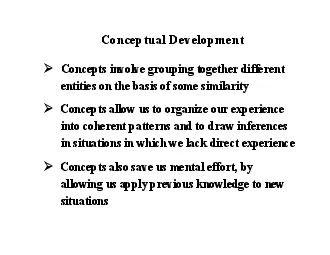

How Do People Represent ConceptsDefining Features Representation Define concepts in terms of a few necessary and sufficient propertiesimaginaryhas great powersAll examples are equally goodHow Do Peop ID: 900274
Download Pdf The PPT/PDF document "Conceptual DevelopmentConcepts involve g..." is the property of its rightful owner. Permission is granted to download and print the materials on this web site for personal, non-commercial use only, and to display it on your personal computer provided you do not modify the materials and that you retain all copyright notices contained in the materials. By downloading content from our website, you accept the terms of this agreement.
1 Conceptual DevelopmentConcepts involve g
Conceptual DevelopmentConcepts involve grouping together differententities on the basis of some similarityConcepts allow us to organize our experienceinto coherent patterns and to draw inferencesConcepts also save us
2 mental effort, byallowing us apply previ
mental effort, byallowing us apply previous knowledge to newsituations How Do People Represent Concepts?Defining Features Representation : Define concepts in terms of a few necessary and sufficient propertiesimagina
3 ryhas great powers All examples are equ
ryhas great powers All examples are equally good How Do People Represent Concepts?Defining Features Representation ballsdolls Do Childrens Concepts Differ From Adult Concepts?Representational Development Hypothesis
4 incomplete superordinategroupings Stage
incomplete superordinategroupings Stage Thematic Groupings (6 yr olds) 2nd Stage Chain Concepts (7-8 year olds)mention same feature, but different fortaking an item and linking all others to itassociative links
5 3rd Stage SuperordinateConcepts (9-11 y
3rd Stage SuperordinateConcepts (9-11 yr olds)6 yrs 50% superordinate9 yrs 75% superordinate11 yrs 95% superordinate Childrens Concepts: Changing Basis of Organization with AgeTask: that belong from an array of
6 pictures of familiar objectsPerceptual f
pictures of familiar objectsPerceptual features first (6 yrs old)the barn and apple go together because they are both redthe clock and ruler go together because they Finally, superordinategroupings (10 yrs old) H
7 ow Do People Represent Concepts?Probabil
ow Do People Represent Concepts?Probabilistic Representation bilisticrelations between the concept and Probabilistic RepresentationsCue Validities: presence of feature increases the likelihood its a member of a conc
8 epte.g., has gills (fish?)sit on it (
epte.g., has gills (fish?)sit on it (chair?)red (apple?)Mistakes can be made based on common featurese.g., a bat is a birddolphins are fish Probabilistic RepresentationsBasic Level Categories: furniture chair k
9 itchen chairanimal bird canaryvehicle
itchen chairanimal bird canaryvehicle car Saab Probabilistic RepresentationsCorrelated Features: features of natural e.g., things that bark, also tend to have four legs, a tail, a wet nose, sharp teeth and fur Pr
10 ototypes: There are more representative
ototypes: There are more representative instances of a concept, these instances have high cue validitiese.g., a robin flies, builds a nest in a tree, has a bird song, is a typical bird sizea penguin has none of these
11 features How Do People Represent Conce
features How Do People Represent Concepts?Theory-Based Representation : There is more to concepts than correlations among features or defining features. Concepts also embody theoretical beliefs about the world and
12 the relations of entities to each other.
the relations of entities to each other.What concept has the following members: children, portable TVs, jewelry, and photo albums? answer: the things we would take out first from a burning home Theory-Based Repre
13 sentationsTheoretical beliefs about the
sentationsTheoretical beliefs about the world influence our reactions to new information.e.g., Today I saw a car with orange wheelssituation is novel, but not implausibleWe might imagine the owner is a prankster or
14 hippie, & the whole car may be brightly
hippie, & the whole car may be brightly painted.situation is novel, but also implausibleWe infer it cannot move, that is was not supposed to move, perhaps its a sculpture. Theory-Based RepresentationsMost concepts ar
15 e partial theories, that include explana
e partial theories, that include explanations that include causal relations.e.g., Why do yaks have four legs rather than three or fiveA child might respond by noting that four legs can be moved in pairs, which allow
16 s yaks to run relatively quickly and sti
s yaks to run relatively quickly and still maintain their balance.The child also uses her knowledge about animals in general to produce an explanation. Theory-Based RepresentationsCore Theories: concerning inanimat
17 e objects-concerning living thingsconce
e objects-concerning living thingsconcerning the human mind What Can We Conclude About Childrens Conceptual RepresentationsChildren from a very early age use all threetypes of conceptual representationsThe prominenc
18 e of different types of conceptualchange
e of different types of conceptualchanges with understanding/age. Early onchildren may rely on probabilistic conceptsTheory-based representations may form later for some concepts, with defining featurerepresentations